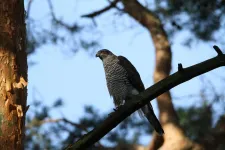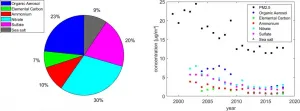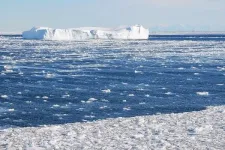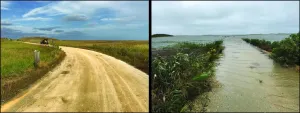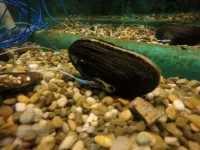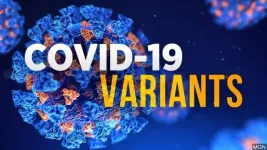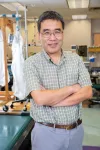Rare fossilized algae, discovered unexpectedly, fill in evolutionary gaps
New study published in Geology
2021-03-23
(Press-News.org) Boulder, Colo., USA: When geobiology graduate student Katie Maloney trekked into the mountains of Canada's remote Yukon territory, she was hoping to find microscopic fossils of early life. Even with detailed field plans, the odds of finding just the right rocks were low. Far from leaving empty-handed, though, she hiked back out with some of the most significant fossils for the time period.
Eukaryotic life (cells with a DNA-containing nucleus) evolved over two billion years ago, with photosynthetic algae dominating the playing field for hundreds of millions of years as oxygen accumulated in the Earth's atmosphere. Geobiologists think that algae evolved first in freshwater environments on land, then moved to the oceans. But the timing of that evolutionary transition remains a mystery, in part because the fossil record from early Earth is sparse.
Maloney's findings were published yesterday in Geology. She and her collaborators found macroscopic fossils of multiple species of algae that thrived together on the seafloor about 950 million years ago, nestled between bacterial mounds in a shallow ocean. The discovery partly fills in the evolutionary gap between algae and more complex life, providing critical time constraints for eukaryotic evolution.
Although the field site was carefully chosen by Maloney's field team leader, sedimentologist Galen Halverson, who has worked in the region for years, the discovery was an unexpected stroke of luck.
"I was thinking, 'maybe we'll find some microfossils,'" Maloney said. The possibility of finding larger fossils didn't cross her mind. "So as we started to find well-preserved specimens, we stopped everything and the whole team gathered to collect more fossils. Then we started to find these big, complex slabs with hundreds of specimens. That was really exciting!"
Determining if traces like the ones Maloney found are biogenic (formed by living organisms) is a necessary step in paleobiology. While that determination is ultimately made in the lab, a few things tipped her off in the field. The traces were very curvy, which can be a good indicator of life, and there were visible structures within them. The fact that there were hundreds of them twisted together sealed the deal for her.
Few people would likely have noticed the fossils that day.
"We were really lucky that Katie was there to find them because at first glance, they don't really look like anything," Maloney's advisor, Marc Laflamme, said. "Katie is used to looking at very weird looking fossils, so she has a bit of an eye for saying, 'This is something worth checking out.'"
Maloney and her colleagues in the field wrestled the heavy slabs into their helicopter for safe transport back to the lab at the University of Toronto-Mississauga. She, Laflamme, and their collaborators used microscopy and geochemical techniques to confirm that the fossils were indeed early eukaryotes. They then mapped out the specimens' cellular features in detail, allowing them to identify multiple species in the community.
While Maloney and her coauthors were writing up their results, they were confident they had found the first macroscopic specimens from this critical time period. During the peer review process, though, they received word from a collaborator that another group in China had made a similar discovery at about the same time--macrofossils from a similar period. That did not dissuade them.
"What's a few hundred million years between friends?" Laflamme laughed. "I think our fossils have more detail, which makes them easier to interpret... They're beautiful. They're huge, they're well detailed, there's anatomy. Your eyes are just drawn to them."
Ultimately, having two sets of macrofossils from approximately the same time can only improve the timeline of eukaryotic evolution, serving as critical calibration points for DNA-based biologic dating techniques. The new fossils also push back the time when algae were living in marine environments, indicating that evolution had already occurred in lakes on land. But for Maloney, an expert in sedimentology, they also raise questions about what gets preserved in the rock record and why.
"Algae became really important early on because of their role in oxygenation and biogeochemical cycles," Maloney said. "So why does it take them so long to show up reliably in the fossil record? It's definitely making us think more about animal ecosystems and whether or not we're seeing the whole picture, or if we're missing quite a bit from a lack of preservation."
The whole project has been engaging for Maloney, who pivoted to algae from more recent biota. "I never expected to be fascinated by algae," she said. "But I was pleasantly surprised as I started investigating modern algae, finding what an important role they play in sustainability and climate change--all these big issues that we're dealing with today. So it's been amazing contributing to algae's origin story."
INFORMATION:
This fieldwork was carried out with permits on traditional lands of the First Nation of Na-Cho Nyak Dun with their consent.
FEATURED ARTICLE
New multicellular marine macroalgae from the early Tonian of northwestern Canada
Authors: Katie M. Maloney; Galen P. Halverson; James D. Schiffbauer; Shuhai Xiao; Timothy M. Gibson; Maxwell A. Lechte; Vivien M. Cumming; Alexie E.G. Millikin; Jack G. Murphy; Malcolm W. Wallace; David Selby; Marc Laflamme
Contact: katie.maloney@mail.utoronto.ca; marc.laflamme@utoronto.ca
URL: https://pubs.geoscienceworld.org/gsa/geology/article/doi/10.1130/G48508.1/595633/New-multicellular-marine-macroalgae-from-the-early
GEOLOGY articles are online at http://geology.geoscienceworld.org/content/early/recent. Representatives of the media may obtain complimentary articles by contacting Kea Giles at the e-mail address above. Please discuss articles of interest with the authors before publishing stories on their work, and please make reference to GEOLOGY in articles published. Non-media requests for articles may be directed to GSA Sales and Service, gsaservice@geosociety.org.
https://www.geosociety.org
[Attachments] See images for this press release:
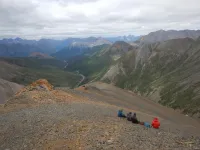
ELSE PRESS RELEASES FROM THIS DATE:
2021-03-23
Over the past decades, the increased use of chemicals in many areas led to environmental pollution - of water, soil and also wildlife. In addition to plant protection substances and human and veterinary medical drugs, rodenticides have had toxic effects on wildlife. A new scientific investigation from scientists of the Leibniz Institute for Zoo and Wildlife Research (Leibniz-IZW), the Julius Kühn Institute (JKI) and the German Environment Agency (Umweltbundesamt - UBA) demonstrate that these substances are widely found in liver tissues of birds of prey from Germany. Anticoagulant rodenticides, commonly used to kill rodents in agriculture and forestry, were frequently detected, particularly in birds of prey close to or in urban environments. ...
2021-03-23
DALLAS - March 23, 2021 - Vaccinating health care workers resulted in an immediate and notable reduction of positive COVID-19 cases among employees, reducing the number of required isolations and quarantines by more than 90 percent, according to data at UT Southwestern Medical Center published in the New England Journal of Medicine.
Health care workers were among the first groups to be eligible for vaccination.
"Real-world experience with SARS-CoV-2 vaccination at UT Southwestern demonstrated a marked reduction in the incidence of infections among our employees, preserving the workforce when it was most needed," notes Daniel K. Podolsky, M.D., president of UT Southwestern and senior author.
During ...
2021-03-23
ITHACA, N.Y. - New research from Mildred Warner, professor of city and regional planning at Cornell University, shows that state laws designed to hinder union activity and indulge corporate entities do not enhance economic productivity.
"We find that where state policy is captured by corporate interests, this undermines inclusive growth," Warner said. "These interests see union and city power as a threat, which is why there are groups like the American Legislative Exchange Council, for example, focused on crafting state laws that erode labor protections and enhance corporate interests."
The ...
2021-03-23
California's restrictions on vehicle emissions have been so effective that in at least one urban area, Los Angeles, the most concerning source of dangerous aerosol pollution may well be trees and other green plants, according to a new study by University of California, Berkeley, chemists.
Aerosols -- particles of hydrocarbons referred to as PM2.5 because they are smaller than 2.5 microns in diameter and easily lodge in the lungs -- are proven to cause cardiovascular and respiratory problems.
As a result of strict vehicle emissions laws, organic aerosol levels have been significantly reduced throughout the United States, but the drop has been particularly dramatic ...
2021-03-23
Understanding the evolution of the polar sea ice is not enough to study the effects of the climate change on marine ecosystems in Antarctic seafloors. It is also necessary to determine the intensity of phytoplankton local production during the Antarctic summer, as stated in a new study by a research team of the Faculty of Biology and the Biodiversity Research Institute (IRBio) of the University of Barcelona, published in the journal Marine Environmental Research.
When the sea freezes in Antarctica
Extremely low temperatures, strong ocean currents and the broad seasonal coverage of marine ice are factors that determine the features of the Antarctic marine ecosystems. IN particular, the seasonality ...
2021-03-23
The rate of sea-level rise in the 20th century along much of the U.S. Atlantic coast was the fastest in 2,000 years, and southern New Jersey had the fastest rates, according to a Rutgers-led study.
The global rise in sea-level from melting ice and warming oceans from 1900 to 2000 led to a rate that's more than twice the average for the years 0 to 1800 - the most significant change, according to the study in the journal Nature Communications.
The study for the first time looked at the phenomena that contributed to sea-level change over 2,000 years at six sites along the coast (in Connecticut, New York City, New Jersey and North Carolina), using a sea-level budget. A budget enhances ...
2021-03-23
Researchers at North Carolina State University have designed and demonstrated a new system that allows them to remotely monitor the behavior of freshwater mussels. The system could be used to alert researchers to the presence of toxic substances in aquatic ecosystems.
"When mussels feed, they open their shells; but if there's something noxious in the water, they may immediately close their shells, all at once," says Jay Levine, co-author of a paper on the work and a professor of epidemiology at NC State. "Folks have been trying to find ways to measure how widely mussels or oysters open their shells off and on since the 1950s, but there have been a wide variety ...
2021-03-23
All viruses mutate as they make copies of themselves to spread and thrive. SARS-CoV-2, the virus the causes COVID-19, is proving to be no different. There are currently more than 4,000 variants of COVID-19, which has already killed more than 2.7 million people worldwide during the pandemic.
The UK variant, also known as B.1.1.7, was first detected in September 2020, and is now causing 98 percent of all COVID-19 cases in the United Kingdom. And it appears to be gaining a firm grip in about 100 other countries it has spread to in the past several months, including France, Denmark, and the United States.
The World Health Organization says B.1.1.7 is one of several variants of concern along with others that have emerged in South Africa and Brazil.
"The UK, ...
2021-03-23
Many organisms use sunlight to fuel cellular functions. But exactly how does this conversion of solar energy into chemical energy unfold?
In a recent experiment, an international team of scientists, including two researchers from UWM, sought answers using an advanced imaging technique called time-resolved serial femtosecond crystallography to watch a pigment found in some marine bacteria as it was exposed to sunlight outside the cell.
For this experiment, the researchers documented, for the first time, the dynamics of the "chloride ion-pumping rhodopsin," an atomic "pump," which is jump-started by sunlight and moves chloride ions unidirectionally into the ...
2021-03-23
DALLAS - March 23, 2021 - It's not just your legs and heart that get a workout when you walk briskly; exercise affects your brain as well. A new study by researchers at UT Southwestern shows that when older adults with mild memory loss followed an exercise program for a year, the blood flow to their brains increased. The results were published online today in the Journal of Alzheimer's Disease.
"This is part of a growing body of evidence linking exercise with brain health," says study leader Rong Zhang, Ph.D., professor of neurology at UTSW. "We've shown for the first time in a randomized ...
LAST 30 PRESS RELEASES:
[Press-News.org] Rare fossilized algae, discovered unexpectedly, fill in evolutionary gaps
New study published in Geology

